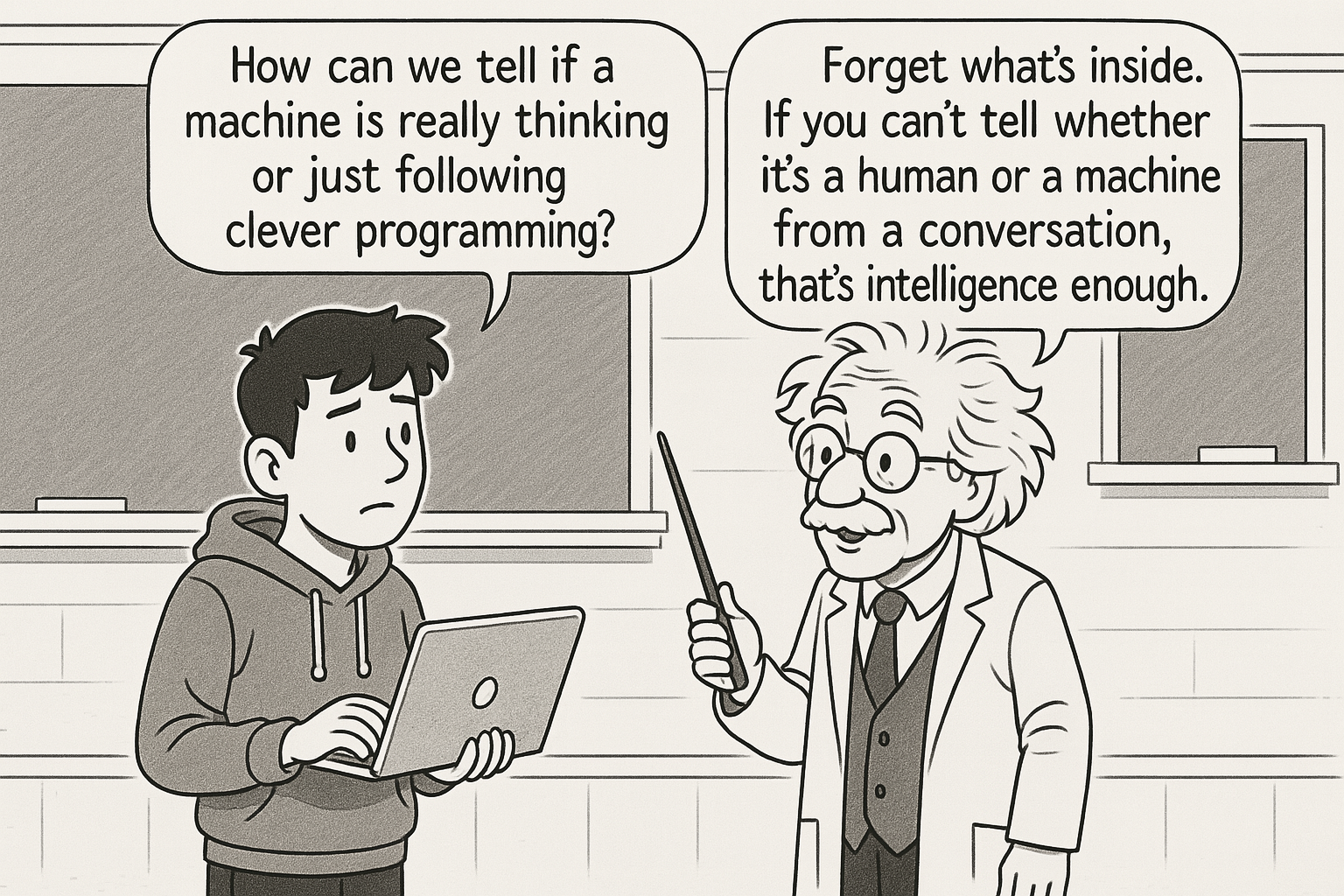Introduction
In 1950, mathematician and computer scientist Alan Turing published "Computing Machinery and Intelligence" in Mind journal, which was the first to introduce his concept of what is now known as the Turing test to the general public. Rather than getting bogged down in philosophical debates about what "thinking" means, Turing proposed a practical test to determine whether machines could exhibit intelligent behaviour. This groundbreaking paper laid the foundation for artificial intelligence as a field and introduced concepts that remain relevant to modern AI development, from chatbots to large language models.
"The question of whether machines can think is replaced by the more practical question of whether they can convincingly imitate intelligent conversation."
Core Ideas
Turing began with the question "Can machines think?" but found this formulation problematic because the words "think" and "machine" cannot clearly be defined. He decided to "replace the question by another, which is closely related to it and is expressed in relatively unambiguous words".
His solution was the Imitation Game, a three-player scenario involving a man (A), a woman (B), and an interrogator (C) who must determine which of the other two is the man and which is the woman through typewritten communication. A's objective is to cause C to make the incorrect identification, while B's objective is to help C make the correct identification.
Turing then proposed a modified version where a computer takes the place of one participant, and the interrogator must determine which respondent is human and which is machine. This became known as the Turing Test, though Turing himself proposed multiple versions of this test between 1950 and 1952.
For his analysis, Turing focused on digital computers because they already existed in 1950 and because digital machinery is "universal" - a digital computer can, in theory, simulate the behaviour of any other digital machine, given enough memory and time. This insight was based on his earlier work on universal computation and what we now call the Church-Turing thesis.
Breaking Down the Key Concepts
Think of Turing's test like a sophisticated version of online chat where you're trying to figure out if you're talking to a human or a bot. The genius of this approach was that it shifted the focus from the internal workings of intelligence to observable behaviour. Just as we judge human intelligence by how people respond to questions and conversations, Turing suggested we should apply the same standard to machines.
His definition of digital computers was remarkably prescient. He described them using the analogy of a human computer - a person who would follow a set of fixed rules using an unlimited supply of paper for calculations. This captured the essence of programmable machines that execute instructions systematically.
The test deliberately separated physical and intellectual capabilities by using written communication only. As Turing noted, there was little point in a 'thinking machine' looking, sounding or feeling like a human for the purpose of testing intelligence. This was a crucial insight that separated intelligence from physical embodiment.

Results and Significance
Turing made a bold prediction: "I believe that in about fifty years' time it will be possible to programme computers, with a storage capacity of about 10^9, to make them play the imitation game so well that an average interrogator will not have more than 70 per cent chance of making the right identification after five minutes of questioning".
To defend his thesis, Turing considered nine common objections, which include all the major arguments against artificial intelligence raised in the years since his paper was first published. These included religious objections (thinking requires a soul), mathematical objections (machines are limited by logical constraints), Lady Lovelace's objection (machines can only do what we program them to do), and arguments about consciousness and various disabilities.
His response to Lady Lovelace's objection was particularly insightful. Turing suggested that this objection could be reduced to the assertion that computers "can never take us by surprise" and argued that, to the contrary, computers could still surprise humans, particularly where the consequences of different facts are not immediately recognisable.
Perhaps most remarkably, Turing anticipated machine learning decades before it became practical. He suggested that "a human mind can be replicated by programming a child's brain that has relatively few processes, and then influencing it with 'education and other experiences'". He compared this to an evolutionary process, where the initial structure of the child-machine corresponds to hereditary material, changes during learning are like mutations, and instead of natural selection, there would be the 'judgment of the experimenter'.
Every conversational AI, from customer service chatbots to advanced language models like ChatGPT, traces its conceptual roots back to the Imitation Game. The questions Turing raised about machine learning, the importance of experience-based training, and the challenge of creating systems that can surprise us with their responses are still central to modern AI development.
Here is the link to the original paper - https://academic.oup.com/mind/article-abstract/LIX/236/433/986238?login=false